
The Saint Laurent class destroyers were the first large warships designed and built in Canada postwar, as ASW escorts tailored for the northwest atlantic conditions. Albeit partly based on the Type 12 and later Whitby class Frigates, they were singular in many aspects and featured numerous innovations, mike an advanced NBC protection, reworked accomodations, modern intercom, operation room, and the best radars and sonars of the day. In al seven were built as the project was reworked into a new class for the follow-up. They were converted as helicopter destroyers (DDH) and modernized in the 1970s and stayed active until the end of the cold war. #coldwar #canadiannavy #RCAN #stlaurent #aswdestroyer
Development
The Canadian Navy was the world’s fourth largest in rank in 1945. RCAN vessels mostly performed intensive escort missions, and largely helped winning the battle of the Atlantic. The country’s own yards managed also to deliver dozens of ships, and others were transferred, like the cruisers HMCS Uganda and Ontario. She also even had escort carrier experience with the HMS Nabob and HMS Puncher. But its greatest wartime constructions were the destroyers of the Tribal class, HMCS Athabaskan, Haida, Huron, Iroquois, Cayuga, Micmac and Nootka. Some were completed postwar. They were very classic ships, with an all-gun armament (eight main guns), powerful AA and two quintuple TT banks. The last Halifax ships were launched in 1944-46, and would serve until the 1960s. it was recoignised however that their 1936 design was not completely obsolete.
When in 1949 Canada joined NATO and with the Cold War just heating up, the US recoignised the Soviet submarine threat in the Atlantic was the largest naval threat so far, and the the Royal Canadian Navy (RCN) was assigned responsibility for anti-submarine warfare (ASW) like in WW2, controlling its own sea space, but extended to the northwestern Atlantic, up to Greenland. The Tribals were seen as not best adapted for ASW warfare and so design work for a new class of Canadian-built destroyer escorts started by June 1949. Since these ships were to be tailor-designed and built entirely in Canada, the original completion date was scheduled for 1955.

Whitby design, close to the unbuilt Type 12 frigates of the RN, which were used partly as base
They were designed by Montreal naval architects German and Milne, under direction of a senior constructor, Sir Rowland Baker. Her was assisted by the British Director of Naval Construction as this task was brand new in Canada. Baker designed a ship that was largely inspired by the Whitby-class (Type 12) frigate, as the RN had the same specifications while being assigned the north sea and north Atlantic up to Greenland. However Baker incorporating many new ideas of his own and the ships ended after two years of design work very different in appearance to the Type 12 design, albeit sharing many traits. So how these frigates could be re-rated as destroyers ? This was not linked to their tonnage or capabilities but purely a choice in nomenclature by the RCN which rated them at first as “escort destroyers” in the USN sense (the British preferred “frigates” for the same role).
An Innovative Design

Part of it came our of an operational requirement close to the one generated the Type 12, even same machinery plant. But the hull eceoved for example a rounded deck-edge forward adopted to prevent ice forming and in general the superstructure was bulkier, stronger, made for harsher conditions. Notably winter gales and ice. But they were also designed as BNC ships (nuclear, biological and chemical attacks) and partially sealed with internal air conditioning, heating and slight overpressure as well as pre-wetting system to wash away contaminants. Her living spaces were placed inside a “citadel” that be sealed off from contamination for the crew safety. So these were the most advanced NBC protected ships of the day. In hindsight, these precautions appears a bit of overmatch, and complicated the internal layout.

She also had a rounded hull, continuous main deck, and were popular with their crews still, as they were called “Cadillacs” for ther spacious and well designed crew compartments and first in the RCN to grant an individual bunk and locker for every crew member, ditching WW2 hammocks. In short, they were very modern and reflected similar daring endeavour in the aerospace Canadian industry.
Innovative design features went on, like a well protected operations room separated from the bridge, with all organs allowing the captain to command the ship in combat from there. There were also 12 separate internal telephone systems for redundancy, and the last in air conditioning technology, as well as the best planned radar and sonar technologies that could be installed at the time, with already a modular approach for future upgrades.
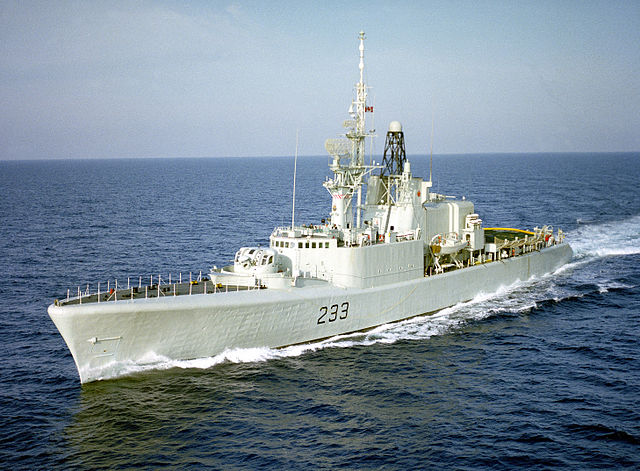
Construction
The St. Laurent class was at first envisioned by the RCN staff as a 14-ships program, to be commissioned no later than 1955, but changing design specifications as the cold war itself evolved rapidely,and Canada’s wartime priorities as the Korean War broke out delayed them, with the first seven completed by 1957, remaining seven reworked in depht as the follow-up Restigouche class to incorporate new innovations and better answer new Soviet submarines. They would lead to the Mackenzie class (4 ships 1962–63 tailored to deal with Soviet SSNs) and Annapolis class (2 completed in 1964) with helicopter deck and hangar, built as such from the start. Meanwhile, thuis feature appeared very useful, so much so this motivated the conversion of all St Laurent class destroyer escorts in the 1960s.
Design of the class
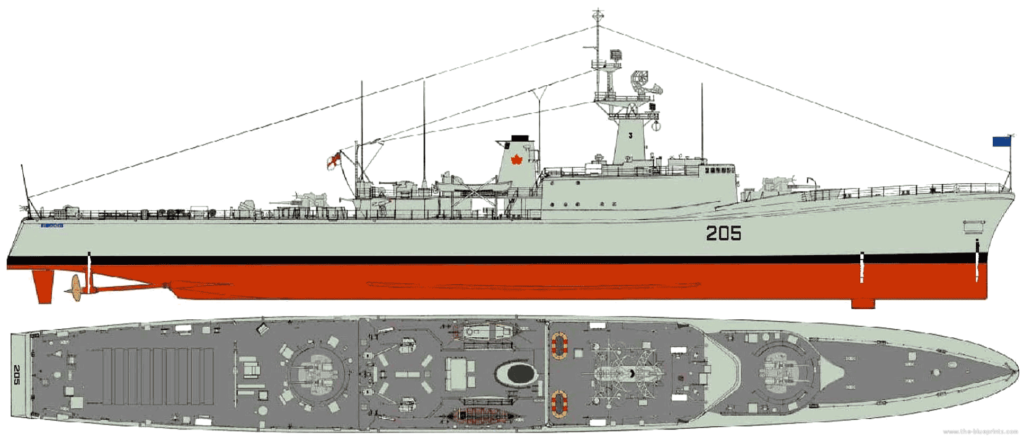
HMCS St Laurent as DDH in 1955 (the blueprints).
Hull and general design
As built, the St Laurent class reached 366 feet (112 m) in lenght (overall), 42 feet (13 m) in beam for a 13 feet 2 inches (4.01 m) draught. They were not scaled as destroyers, but as frigates indeed, displacing just 2,263 tonnes (2,227 long tons) standard, 2,800 tonnes (2,800 long tons) deeply loaded, in stark contrast to the much nimbler, albeit larger Tribals’s at 2,520 long tons (2,560 t) (deep load). In short, they were the largest ships ever built in Canada so far. They had a crew of 12 officers and 237 enlisted, which was much more than the Tribals’ 190.
Still, their philosophy and capabilities were not the same at all. Tribals were old style “gun wagons” designed for close quarter ship to ship combat, whereas the St Laurent were completely new animals, made for long and patient ASW patrols in punishing conditions.
Powerplant
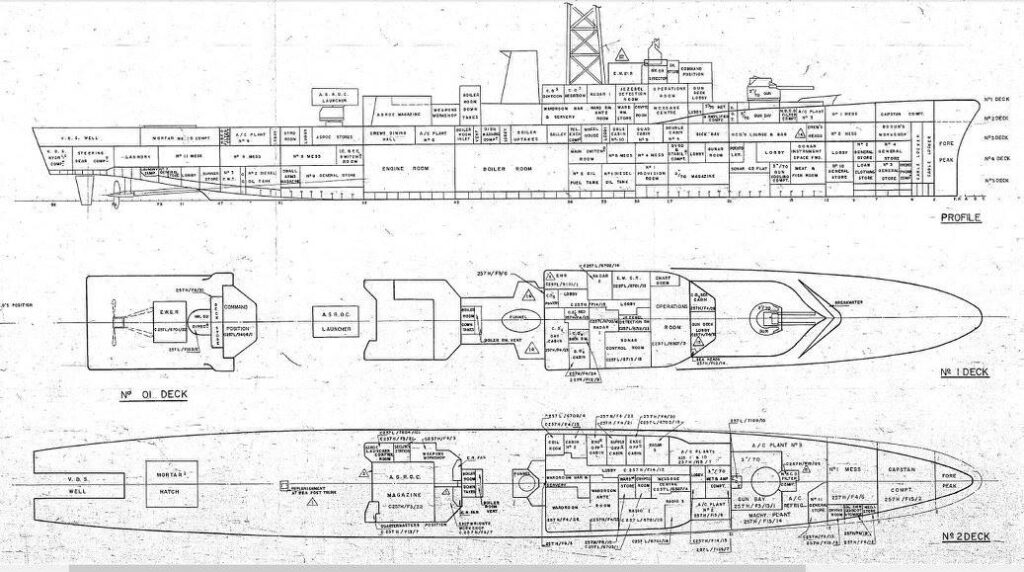
Plans cutaway of the next Restigouche class (facebook, see src below).
The St. Laurent class were powered through two shafts, two geared English Electric steam turbines fed by two Babcock & Wilcox water tube boilers rated for 600 psi (4,100 kPa), 42 (kgf/cm²) at 850 °F (454.4 °C).The general output was 22,000 kilowatts (30,000 shp) for 28.5 knots (52.8 km/h). To compare with the Tribals, twice as much or 44,000 shp (33,000 kW) and 36 knots (67 km/h; 41 mph). But again, they did not played the same game at all. Close to their retirement, they only averaged 27 knots (50 km/h), but shone by their endurance of 4,570 nautical miles (8,460 km) at 12 knots (22 km/h). On the Tribals, this was 5,700 nmi (10,600 km; 6,600 mi) at 15 knots (28 km/h; 17 mph).
British design was used throughout as Canadian Industries xould not yet managed these specialized powerplants. Thus Yarrow & Co Ltd of Scotstoun, Glasgow, provided a complete set to be assembled in Canada by Canadian Vickers with the hope of replicating this machinery and fully manufacturing it in Canada for the remaining ships. So the St Laurent also inaugurated marine powerplant industry in Canada.
Armament
The St. Laurent class for their displacement seemed woefully under-armed with weak main guns, two bofors for AA defense, no torpedoes, no depth charges but two ASW mortars. This was recoignises and corrected on follow-up vessels. At least the later addition of a Sea King ASW helicopter (modernization) brought a valuable increase in capabilities.
Main: 2×2 3-inch/50 Mark 33
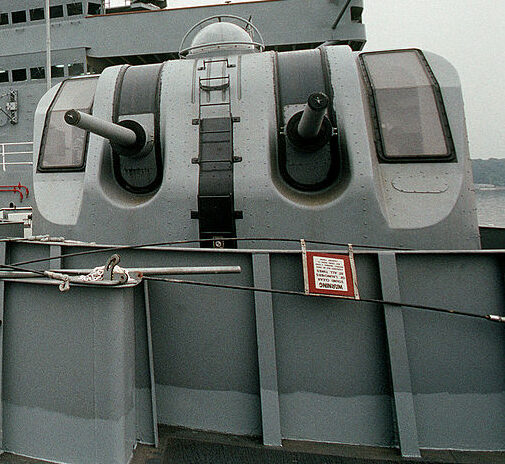
They had a defensive twin 3-inch (76 mm)/L50 mount, dual purpose. The mount had a 85° and a rate of fire of 50 rounds per minute up to a ceiling of 7.9 miles (12.7 km). As built, they were installed without shields, which were added in 1963 but in fiberglass housings only bringing weather protection.
AA: 40mm L/60 Boffin
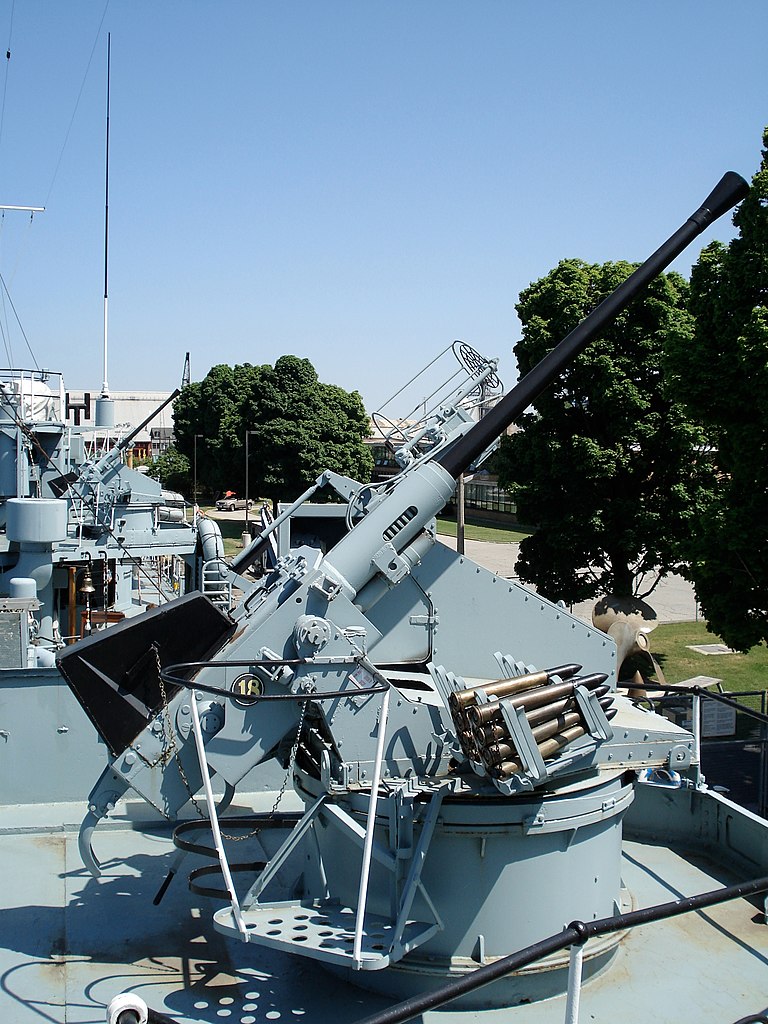
The ships were also fitted with two single-mounted Bofors 40 mm/60 (1.6 in) “Boffin” guns without shield. These modified Canadian Bofors 40 mm Automatic Gun L/60s were widespread in the RCN but close versions were in service in the RN and related to systems throught NATO navies as well, staying relevant until the 1980s.
It used Automatic extraction and integrated cam-operated recoil powered autoloader, with Vertical sliding-wedge, fed by large clip magazines
It fired a 40 × 311 mm R 0.9 kg (2 lb 0 oz) shell at 880 m/s (2,900 ft/s) up to 120 round/min at high elevation angles. It could departed −5° up to +90° at a rate of 55°/sand traverse to 360° at 50°/s while the mounted weighted 522 kg (1,151 lb). Max range was 7,160 m (23,490 ft).
ASW: 2×3 NC 10 Limbo
The main anti-submarine armament comprised two triple-barreled Mk. NC 10 Limbo ASW mortars at the stern in wells, which had a closure roller top in heavy seas. The Mark 10 Limbo Anti-submarine Mortar was already a proven system, which in its 1955 version throws a 400 lb 12-inches (305 mm) depth charge from 400 yards (366 m) to 1,000 yards (914 m). The Warhead contained 94kgs of Minol, using Proximity and/or time Guidance. The weapon system received data by the Type 170 sonar.
Torpedoes were envisioned on these ships just as on the British Type 12 design, and these were to be long-range homing torpedoes BIDDER Mk 20E, or the US Mark 35, albeit they were never fitted.
Sensors
As DDE (escort destroyers) these ships had the following (note, just a list, no data available for most of these systems)
- SPS-12 air search radar
- SSPS-10B surface search radar
- Sperry Mk.2 navigation radar
- SQS-10 or −11 hull mounted active search and attack sonar
- SQS-501 (Type 162) high frequency bottom profiling sonar
- SQS-502 (Type 170) high frequency Limbo mortar control sonar
- UQC-1B “Gertrude” underwater telephone
- GUNAR (Mk.64 GFCS with 2 on-mount SPG-48 directors)
- DAU HF/DF (high frequency direction finder)

⚙ DDE specifications |
|
| Displacement | 2263 tons (normal), 2800 tons (deep load) |
| Dimensions | 366 x 42 x 13 ft (111.6 x 12.8 x 4m) |
| Propulsion | 2-shaft English-Electric GST, 2 Babcock & Wilcox boilers 22,000 kW (30,000 shp) |
| Speed | 28.5 knots (52.8 km/h) |
| Range | 4,570 nautical miles (8,463.6 km) at 12 knots (22.2 km/h) |
| Armament | 2×3 in Mk.33 FMC, 2× 40 mm “Boffin”, 2× Mk NC 10 Limbo, 2× Mk.2 “K-gun”, H Torpedoes |
| Sensors | SPS-12 ASR, SPS-10B SSR, GUNAR FCR, Sperry Mk.2 navR, SQS-10/11 hull sonar, SQS-501, SQS-502 sonars |
| Crew | 249 |
1963 Conversion as Helicopter Destroyers (DDH)
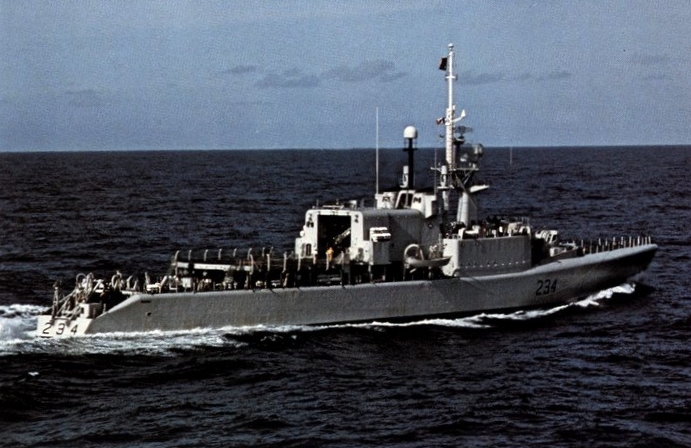
Rear helideck of Assiniboine, door open
With the first Soviet nuclear-powered attack submarines of the late 1950s, the RCN staff reassess their destroyers and planned and answer to the new threat. At first teatly SSNs proved even noisier than earlier conventional submarines so long range detection was ensured. However with a top speed of 30 knots (56 km/h) submerged, the St. Laurents could not keep up. As soon as the ships were completed, there were serious doubts about their efficience, even when patrolling and operating in a hunter killer pair. The 25 February 1959 meeting of the Naval Board in Ottawa, it was decided that the only counter was to add an helicopter capability.
Feasibility of operating ASW helicopters from small escorts was at first not proved, at least until the Prestonian class HMCS Buckingham tested the formula by mid-1956, tseting a temporary helicopter landing platform on her quarterdeck. Trials by October 1956 however were done with a relatively light Sikorsky HO4S-3. They were successful enough to motivate the installation of an even larger and reinforced temporary helicopter landing platform on HMCS Ottawa freshly completed by August 1957. This time a larger RCAF Sikorsky S-58 was tested, and trials success reports gained approval. However this was only the start as the design of the landing platform was to be adapted, and maintenance installation was to be installed, or a hangar if possible.
The RCN also looked after a modern, versatile helicopter capable of all-weather, day-and-night operations. With its armament and load it needed to be better than with the ageing HO4S. There was also to be a way, by defult of a hangar, to secure it on the platform to cope with rough seas and protect it from salty seaspray. Further trials showed pilots were capable of landing in adverse conditions, but deck handling was problematic as manpower alone was insufficiently. HMCS Ottawa trials proved than 30 minutes were needed to secure the S-58 on deck in nighttime, by rough seas. This was solved by the beartrap system, which was suggested and could be manufactured by Fairey Aviation of Dartmouth, Nova Scotia. Ths prototype was installed on HMCS Assiniboine at the occasion of her 1962–63 conversion and made deck handling from landing to the hangar not required anymire, the decide acting as a “carpet”. This also lmeant the hangar was now part of the new design, as it was the only sound protection against the elements and for efficient maintenance by all weather conditions.
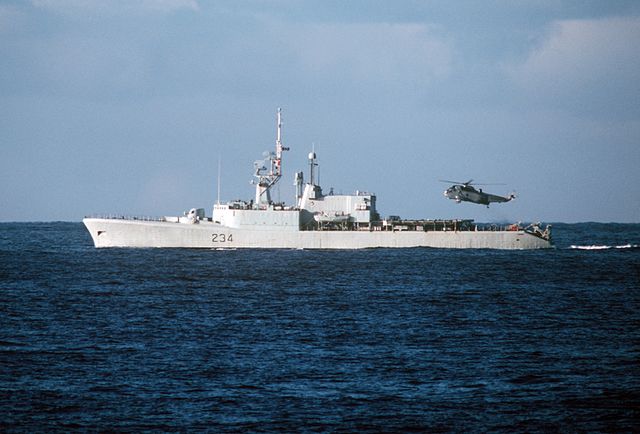
Sea King landing on HMCS Assiniboine in 1986
The first to be converted as DDH, HMCS Assiniboine, was completely gutted aft, down to the engine roof deck level at the waterline, and leaving most of theforward spaces intact. The hull was also strengthened to support the helideck and hangar, and brand new fuelling facilities intsalled for the helicopter. To improve stability, fin stabilizers were also installed into the hull’s sides, to reduce roll.
The six next ships of the St Laurent class received these extensive modifications over two years, with the addition of a brand new electronics suite, and revised armament: The additionof the SQS 504 Variable Depth Sonar (VDS) also brought a welcome long range passive detection capability. It was installed earlier from 1961, and the helicopter platform followed later. The single funnel was was split in two stepped funnels so that the hangar extension could fit in between. The helicopter deck was placed over the former aft 3-inch mount and one of the aft Limbos was removed as well. The two 40 mm guns were also removed at the time, not replaced. Displacement increased at full load as well as draught.
Initially the admiralty tested two helicopters and ultimately the Sikorsky S-61 (HSS-2) Sea King and Kaman K-20 (HU2K) were retained, for the former winning the competition in December 1961.
Assiniboine was re-commissioning as DDH on 28 June 1963 and started operations from 27 November 1963, to land the first Canadian built CHSS-2 Sea King, also using her beartrap landing system with success.
Later Modifications
In the late 1970s, the ships narrowly avoided decommission, and benefited instead of the Destroyer Life Extension (DELEX) program. The plan was to further upgrade ten destroyers (seven St Laurent and three Restigouche) with new electronics. The machinery woulkd be completely overhaul as well as the elevtric installation, generators and many internal systems, but also hull upgrades. It was planned to keep them to the late 1980s. It was in the end more austere than anticipated.
⚙ DDH specifications |
|
| Displacement | 2260 tons (normal), 3051 tons (deep load) |
| Dimensions | Same but draft 14* ft (4.3m*) |
| Armament | 1×3 in/50 Mk.33 FMC, Mk NC 10 Limbo ASW mortar, 2×3 Mk.32 12.75-in (Mk.44/46 Mod 5 torp.) |
| Sensors | Same but URN 20 TACAN, SQS-504 VDS |
| Air Group | CH-124 Sea King, deck, Beartrap and hangar |
| Crew | 213 plus 20 aircrew |
General assessment
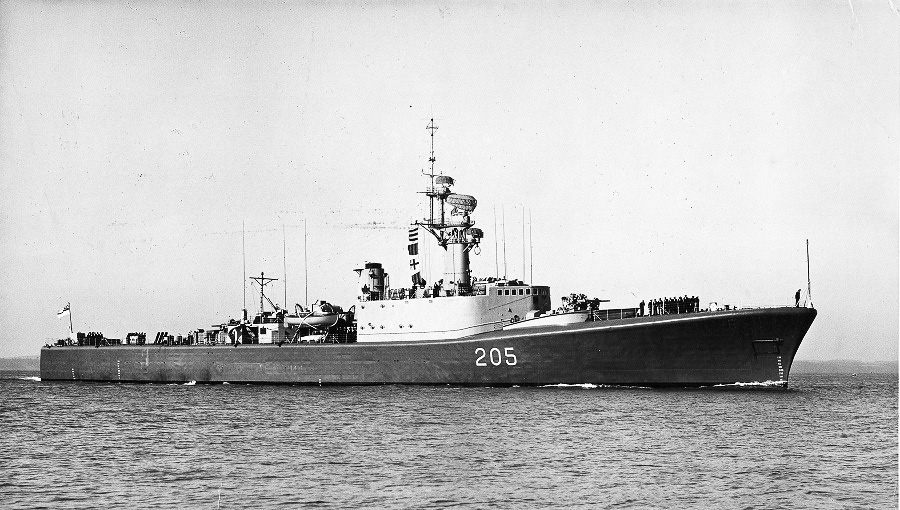
HMCS St Laurent as completed with a singular black hull. Later it was changed for an overall light gray livery, dark gray for the decks.
Laid down between November 1950 and May 1952, completed by October 1957, they soon were found inadequate in 1958 already with NATO intel on new Soviet SSNs such as the November class. HMCS Assiniboine served with the RCN at Halifax in Nova Scotia and stayed on the east coast until transferred to the west coast, converted in 1962 as helicopter destroyer, test and lead ship for her class. HMCS Fraser was six years on the west coast, and aided the yacht Redwitch in 1960 and Yaqui Queen in 1964 stranded with a storm. This class was indeed designed soundly and could cope with the worst weather conditions. In 1965, Fraser received shock tests off Hawaii (survival capabilities) which proved successful. She was conveted as DDH at Vickers shipyard in Montreal. HMCS Margaree was assigned to the west coast and after many port visits and large NATO naval exercises she was conveted as DDH at Victoria Machinery Depot in British Columbia.
These ships were long to built, but opened brand new alleys for the RCN. They spawned a serie of very similar vessels that would be built until the late 1960s and proved well adapted for their rle and area of operation. They proved valuable for NATO as well as to restore confidence in Canadian shipbuiding capabilities postwar.
In 1997, the Historic Sites and Monuments Board of Canada stated this class was “historically significant to Canadians”. In 2000 a bronze plaque was installed aboard Fraser. This plaque read:
St. Laurent Class of Canadian Warship:
The pride of the Canadian Navy during the Cold War, these anti-submarine escorts were the first naval vessels conceived and built in Canada. Designed in 1948–1949, they influenced naval construction internationally with their smooth above-water surfaces and distinctive convex deck. They could also be sealed to protect crews against biological and radioactive threats. All seven St. Laurent-class ships were modified during the 1960s to carry helicopters and enhance their anti-submarine capability. Launched in 1953, HMCS Fraser is the last surviving example of this innovative class of warship.
Read More/Src

Books
Conway’s says 2000 tons standard displacement, 2600 deep load.
Jane’s Fighting Ships 1963–64 shows photographs taken in 1962 and 1963 respectively of Skeena and Assiniboine with these.
Barrie, Ron; Macpherson, Ken (1996). Cadillac of Destroyers: HMCS St. Laurent and Her Successors. St. Catharines, Ontario: Vanwell Publishing Limited. ISBN 1-55125-036-5.
Blackman, Raymond V.B., ed. (1963). Jane’s Fighting Ships 1963–64. London: Sampson Low, Marston & Co. Ltd. ISBN 0070321612.
Gardiner, Robert; Chumbley, Stephen; Budzbon, Przemysław, eds. (1995). Conway’s All the World’s Fighting Ships 1947–1995. Annapolis, Maryland: Naval Institute Press. ISBN 1-55750-132-7.
Friedman, Norman (1986). The Postwar Naval Revolution. Naval Institute Press. ISBN 0-87021-952-9.
Sharpe, Richard, ed. (May 1992). Jane’s Fighting Ships 1992–93 (85th ed.). Jane’s Information Group. ISBN 0710609833.
Soward, Stuart E. Hands to Flying Stations, a Recollective History of Canadian Naval Aviation, Volume II. Victoria, British Columbia: Neptune Developments, 1995. ISBN 0-9697229-1-5.
Crowsnest Magazine – Vol 17, Nos 3 and 4 March–April 1965
Links
http://www.hazegray.org/navhist/canada/postwar/stlauren/
https://commons.wikimedia.org/wiki/Category:St._Laurent_class_destroyer
https://en.wikipedia.org/wiki/St._Laurent-class_destroyer
https://www.seaforces.org/marint/Canadian-Navy/Destroyer/St-Laurent-class.htm
https://www.navypedia.org/ships/canada/can_es_st_laurent.htm
https://www.thecanadianencyclopedia.ca/en/article/st-laurent-class-destroyer-escorts
restigouche plans – hazegray.org/
https://www.seaforces.org/marint/Canadian-Navy/Destroyer/DDH-205-HMCS-St-Laurent.htm
https://alchetron.com/HMCS-Margaree-%28DDH-230%29
https://www.silverhawkauthor.com/post/royal-canadian-navy-destroyers-st-laurent-restigouche-mackenzie-and-annapolis-class-1950-1989
https://www.canada.ca/en/navy/services/history/ships-histories/st-laurent.html
Videos
Canadian St. Laurent Class Destroyer Circa 1960 USS Bennington CV-20 – HMCS Ottawa – RFA Tidesurge
Model Kits
modelwarships.com reviews stlaurent-1:350
restigouche plans facebook
 St. Laurent (DDE 205)
St. Laurent (DDE 205)

HMCS Saint Laurent, first of her class, was laid down at Canadian Vickers Ltd. in Montreal, 24 November 1950, and she was launched 30 November 1951 and completed on 29 October 1955. After her commission she sailed to the US east coast for evaluation and weapons/sensors qualifications, before visiting UK. She escorted the yacht HMY Britannia to Sweden and later other diplomatic duties. She was also the first to test the variable depth sonar.
Before conversion as DDH she was assigned to the 2nd Canadian Escort Squadron in 1960, Esquimalt, British Columbia. By February 1960 she started a training cruise around the Pacific with port visits and back in April. In March 1961, with Ottawa and Saguenay she trained with the US Carrier Division 17 off Hawaii. Her DDH refit spanned between mid-1962 and 4 October 1963. She was reassigned to the east coast and by 1964, with Mackenzie and Fraser she made another Pacific training cruise.
In 1966 she sailed with Gatineau to the Bahamas (independence celebrations) and in 1969, tracked a Soviet task force transiting through Canadian waters which was sailing to Cuba.
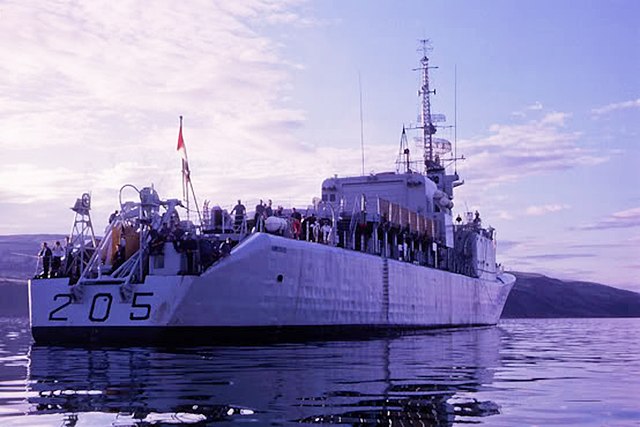
St. Laurent her had keel badly damaged toward the end of her career so was paid off early and not modernized under the DELEX program. On 14 June 1974 she was stationed, decommissioned in Halifax providing spare parts for her sisters still in service, until sold on 27 September 1979 and while en route to Texas to be BU, she met a powerful storm, foundereding off Cape Hatteras, 12 January 1980, now a coral reef.
 Saguenay (DDE 206)
Saguenay (DDE 206)
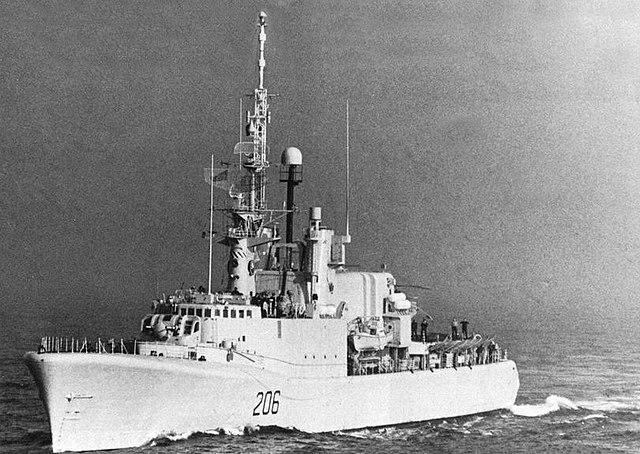
HMCS Saguenay was laid down at Halifax Shipyards Ltd. 4 April 1951, launched 30 July 1953, completed on 15 December, assigned to the east coast. In 1959 this was the west coast, 2nd Canadian Escort Squadron. February 1960 with Ottawa and St. Laurent she made first Pacifi cruise and back to Esquimalt in April. The same happened in 1961, training with US CarDiv 17 in Hawaii.
Her DDH conversion was performed at Burrard Dry Dock of Vancouver from 22 August 1963 to 14 May 1965. She served from Halifax with the east coast fleet, and 1st Canadian Destroyer Squadron. by 16 July 1970 she ran aground off Cape Breton, refloated. By April 1971 she joined the 5th Canadian Destroyer Squadron.
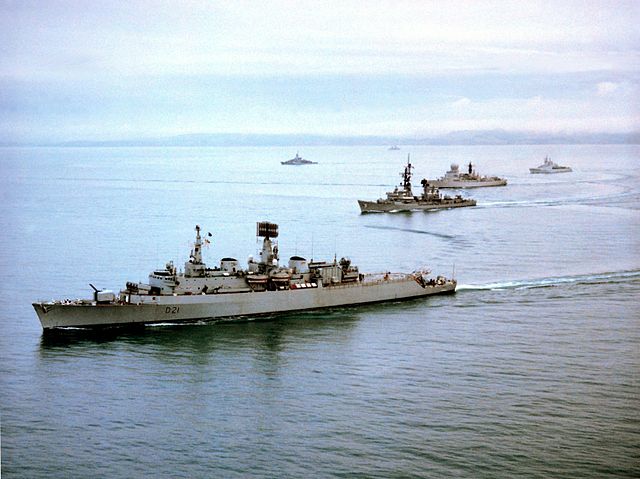
Se underwent the DELEX upgrade from 29 October 1979 to 23 May 1980 at Versatile Vickers, Montreal. By 3 April 1986 injuries were caused by a 3-inch shell misfire, including the gun crew and civilian technicians on board. On 16 August in a NATO exercise she collided with the German submarine U-17, and packed home for repairs. In 1987 she resumed service and in 1989, repelled an American fishing boat entering Canadian waters, the Concordia, which refused to stop and went so far as bumping the destoyer three times. After accurate firing warning shots it returned eventually to American waters. Saguenay was decom. on 26 June 1990, sold 1994 ended as artificial reef/recreational dive site off Cross Island (Lunenburg Bay).
 Skeena (DDE 207)
Skeena (DDE 207)
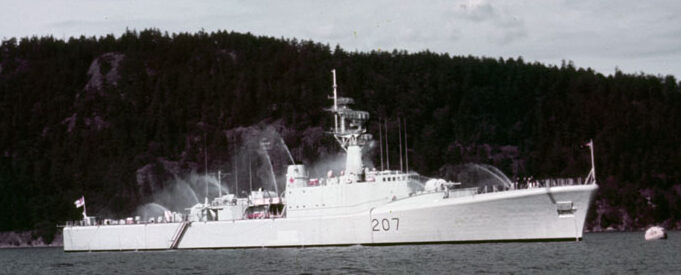
HMCS Skeena was built at Burrard Dry Dock Ltd. North Vancouver in British Columbia, laid down on 1 June 1951, launched on 19 August 1952, and completed on 30 March 1957. She was assigned to the 2nd Canadian Escort Squadron in Esquimalt, British Columbia. The latter started a training cruise around the Pacific by January 1958 until 2 April. On 29 January 1962 she shelled an American village in the Strait of Juan de Fuca, Clallam Bay, Washington, by accident during gunnery practice. Capt. Richard H. Leir faced court-martial, and was convicted.
Skeena was converted as DDH at Davie Shipbuilding at Lauzon, Quebec in 1964 and until 14 August 1965, reassigned to the 3rd Canadian Escort Squadron at Halifax. In 1972, she was designated to host more Canadian Francophones, with the language spoked aboard. The 1976 Summer Olympics saw her securing the St Laurent river in front of Montreal.
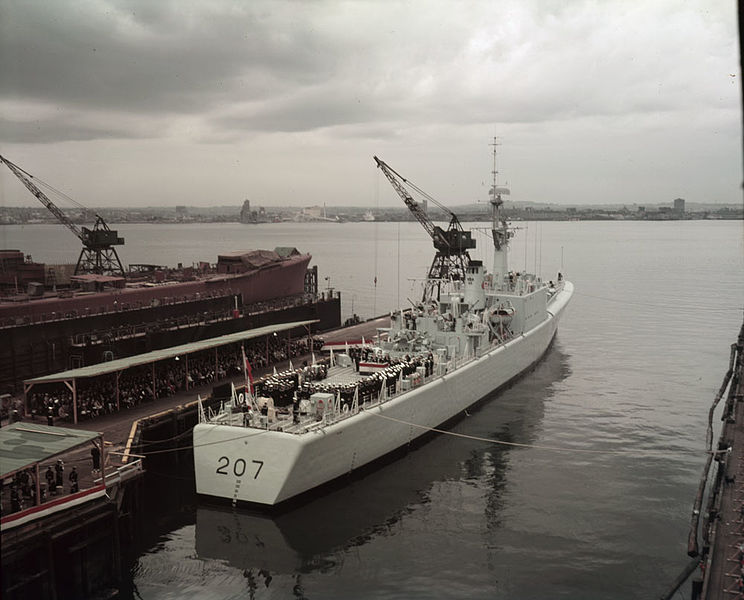
Selected for DELEX she was refitted on 20 November 1981 at Montreal until 4 January 1982. May 1985 saw her taking part in STANAVFORLANT. On 24–26 May she teamed with USS Richard E. Byrd to shadown a Soviet task force off Portugal. In 1991 she took part in Ocean Safari 91, and later STANAVFORLANT in July 1992, touring also the Caribbean and Europe. She was decom. on 1 November 1993, sold in 1994 to Indian brokers in 1996.
 Ottawa (DDE 229)
Ottawa (DDE 229)
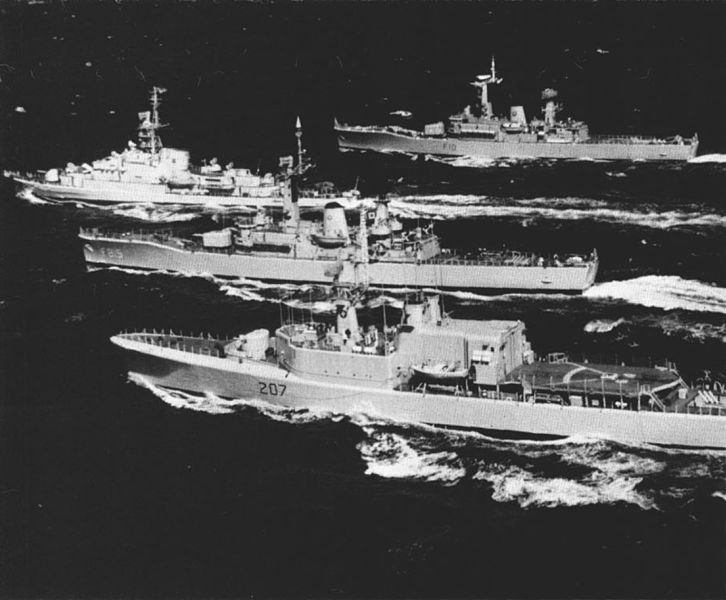
HMCS Ottawa was laid down at Canadian Vickers on 8 June 1951, launched 29 April 1953, completed on 10 November 1956. She became a test ship for helicopter landing trials until transferred to the west coast, joined the 2nd Canadian Escort Squadron. February 1960 saw her with St. Laurent and Saguenay in an Asian cruise to Hong Kong and Japan and training with the Japanese Maritime Self-Defense Force. In March 1961 she trained with CarDiv 17 off Hawaii. She was converted as DDH at Victoria, British Columbia from 24 May 1963 to 21 October 1964 and returned to the east coast.
On 15 July 1968 she became the first bilingual ship of Maritime Command under French Language Unit (FLU). In 1976 she escorted the royal yacht HMY Britannia from UK to Canada and took part in NATO Teamwork ’76. In 1977 she sailed to USSR with Margaree and Athabaskan and later STANAVFORLANT for two months.
In 1981, an inspection urge change of superheater cracking boilers. Soon all the other St. Laurent-class were inspected and repaired. She underwent the DELEX program from 19 April to 26 November 1982 at Canadian Vickers. By the summer of 1988, she cruised the St. Lawrence River to the Great Lakes with ports visits. On 6–16 June 1991 she took part in NATO Ocean Safari 91. She was decommissioned on 31 July 1992 at Halifax, sold February 1994 to a Florida company but resold and towed to India; BU.
 Margaree (DDE 230)
Margaree (DDE 230)
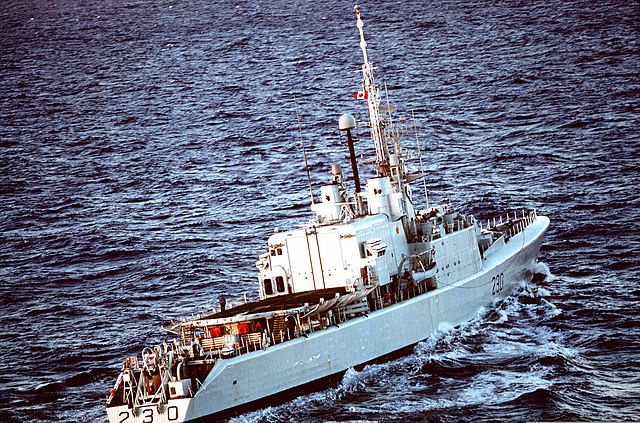
HMCS Margaree was laid down at Halifax Shipyards Ltd. (Nova Scotia), 12 September 1951, launched 29 March 1956, completed 5 October 1957. She was assigned to the west coast fleet, 2nd Canadian Escort Squadron. January 1958 saw her first Pacific cruise, back in in April. In 1962 she took part in NATO JETEX 62 with Assiniboine and Ottawa and by 25 September 1964 entered the Victoria Machinery Depot for her DDH conversion until 15 October 1965, transferred to the east coast. In 1968 she was assigned to the 7th Canadian Escort Squadron.
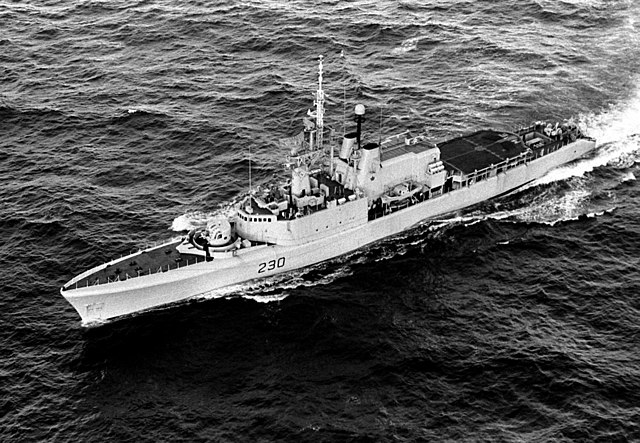
In January 1973, Assiniboine the Protecteur were deployed to STANAVFORLANT (Standing Naval Force Atlantic), a first permanent posting with support ship. By June 1973 she collided with the fisheries research vessel Cygnus. September 1976 she took part in NATO Teamwork 76. On 1 April 1979 she collided with the merchant ship Kurdista, breaking in half on 15 March. Later she underwent the DELEX program update with a refit from 5 May to 28 November 1980 at HMC Dockyard at Halifax.
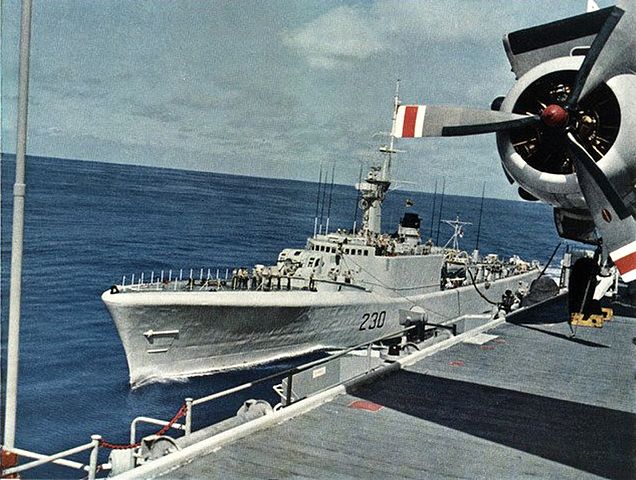
In 1981, cracks in the boiler heads delayed her recommission, and she made several STANAVFORLANT deployments until 8 February 1991. In August 1991, she took part in the re-enactment of the signing of the Atlantic Charter in WW2 at Argentia. She was decommissioned on 2 May 1992, sold to Global Shipping, Tampa, Florida, 3 February 1994, BU in India.
 Fraser (DDE 233)
Fraser (DDE 233)

HMCS Fraser was laid down at Burrard Dry Dock Ltd. North Vancouver on 11 December 1951, launched on 19 February 1953, completed on 28 June 1957. She was assigned to the 2nd Canadian Escort Squadron at Esquimalt. During her first cruise to Pearl Harbor in November 1960, she assisted the crippled yacht Red Witch, until taken over by the United States Coast Guard. On 6 February and March 1965 she had shock trials off Hawaii, successful.
DDH conversion started 2 July 1965 at Canadian Vickers until 22 October 1966. Her first CH-124 Sea King landed on 15 June 1967 and by October 1967 using the beartrap haul-down system whereas off Washington, DC to try to sell the system to the US for their own small escorts. In 1969, she represented Canada at the Spithead Review. In May 1973-March 1974 she was in reserve, then refit at Davie Shipbuilding in Quebec. in 1976 she took part in the maritime security of the Summer Olympics in Montreal.
On 28 November 1980, she rescued twelve British fisherman from St Irene off the Netherlands. She took her turn at STANAVFORLANT and served from Portsmouth and dsailed to the Skagerrak to test a Soviet incursion scenario into Poland. In 1981 she had her DELEX upgrade at Canadian Vickers, Montreal from 19 October 1981 to 28 May 1982.
In 1986, she tested a new Experimental Towed Array Sonar System. In 1987, she also tested the new NIXIE torpedo decoy system, and TACAN antenna. In 1988, she tested the HELTAS Sea King, featuring an airborne passive array sonar.
On 18 October 1993, she was off Haiti to enforce UN sanctions until January 1994. On 10 January she had a minor boiler room fire. In July 1994 she intercepted and seized the US fishing vessels Warrior and Alpha Omega II illegally fishing in the Grand Banks. On 13–14 September, she rescued the sailing vessel Maja Romm.
She wass decommissioned on 5 October 1994, category C reserv, floating classroom at Halifax and then sold to the Artificial Reef Society of Nova Scotia, although discussion for a conversion to a museum ship, needed funding. She hosted a few guided tours by appointment in 2003 and 2004 and hosted Sea Cadets, the LaHave River Tourism Association, Atlantic Lighthouse Council, Bridgewater Fire Department, and Katimavi as well as the annual Canada Day fireworks display. By 1997, she was recoignised as a Canadian historical landmark and preserved.
 Assiniboine (DDE 234)
Assiniboine (DDE 234)
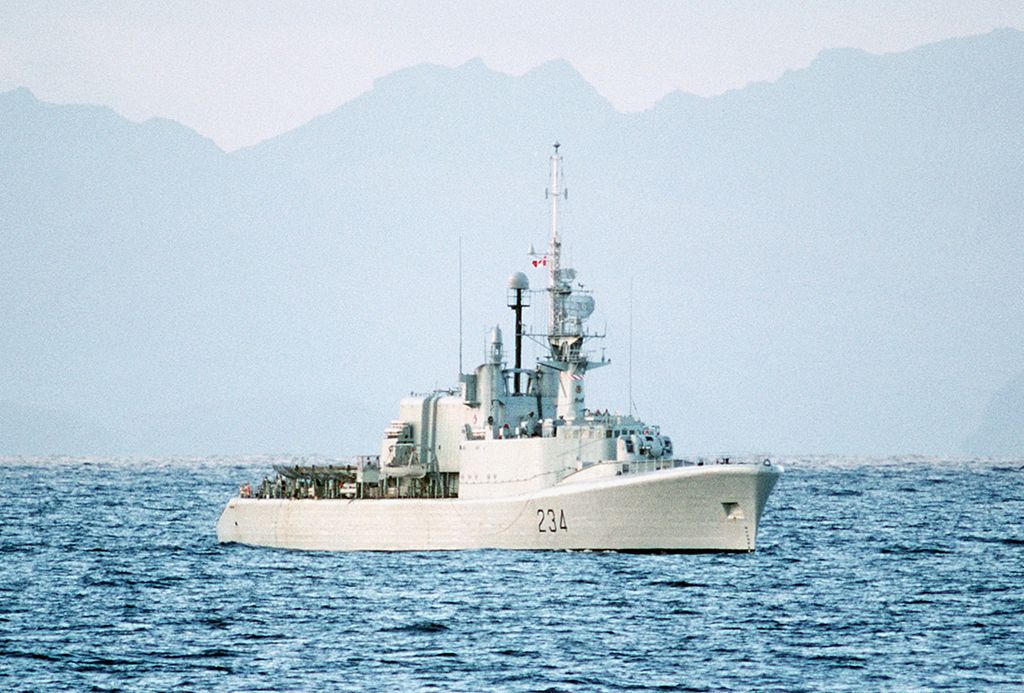
HMCS Assiniboine was laid down at Marine Industries Ltd., in Sorel, Quebec, 19 May 1952, launched on 12 February 1954, completed on 16 August 1956. She was assigned to the east coast, 3rd Canadian Escort Squadron. October to November 1956 saw her touring northern Europe with port visits. In January 1959 she was reassigned to the west coast. In July she carried Queen Elizabeth II and Prince Philip from Vancouver to Nanaimo. She was assigned to the 2nd Canadian Escort Squadron at Esquimalt. Next she had her DDH conversion, and reassigned to the east coast. She tested the beartrap hauldown system in heavy weather on purpose.
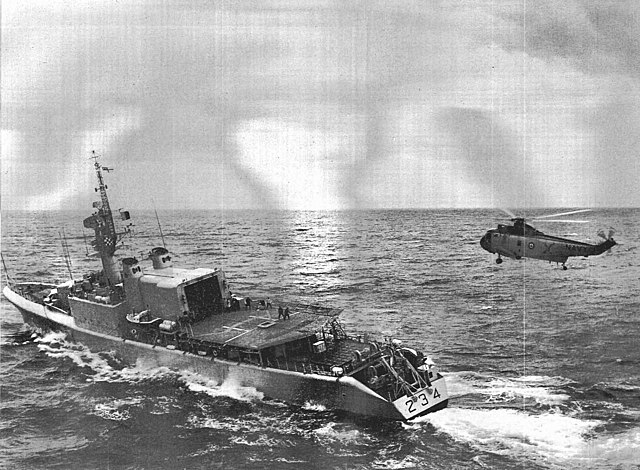
In 1974, she was sent to Lisbon in Portugal for NATO Standing Naval Force Atlantic and when the Carnation Revolution started her crew was ashore. It was recalled in precipitation and she left the area. On 21 January 1975, she recued the crew from the freighter Barma in very high winds. She received her DELEX program of life extension from 23 April 1979 to 16 November at Vickers Ltd. of Montreal. On 2 July 1981 she ran aground in Halifax Harbour by heavy fog but was freed by tugboats. After damage inspection no repairs were required. In 1984 she escorted the Tall Ships race, and looked after the missing sailing vessel Marques. In July 1984 fractures in her upper deck platings urged repairs at MIL Davie Shipbuilding, Sorel for 10-month, later extended to 17 months due to labour strikes. She was decommissione on 14 December 1988, used as harbour training ship at CFB Halifax from 3 January 1989 until sold for BU January 1995 but sank in the Caribbean while under tow.

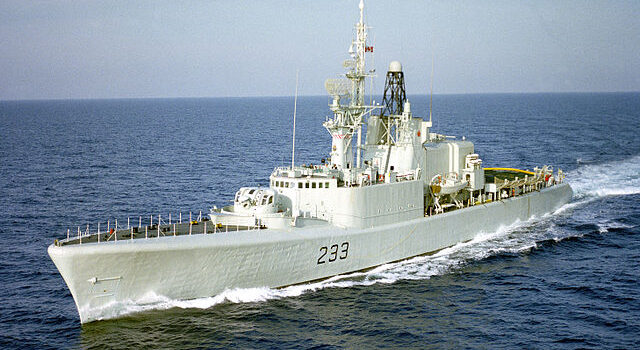
 Latest Facebook Entry -
Latest Facebook Entry -  X(Tweeter) Naval Encyclopedia's deck archive
X(Tweeter) Naval Encyclopedia's deck archive Instagram (@navalencyc)
Instagram (@navalencyc)





 French Navy
French Navy Royal Navy
Royal Navy Russian Navy
Russian Navy Armada Espanola
Armada Espanola Austrian Navy
Austrian Navy K.u.K. Kriegsmarine
K.u.K. Kriegsmarine Dansk Marine
Dansk Marine Nautiko Hellenon
Nautiko Hellenon Koninklije Marine 1870
Koninklije Marine 1870 Marinha do Brasil
Marinha do Brasil Osmanlı Donanması
Osmanlı Donanması Marina Do Peru
Marina Do Peru Marinha do Portugal
Marinha do Portugal Regia Marina 1870
Regia Marina 1870 Nihhon Kaigun 1870
Nihhon Kaigun 1870 Preußische Marine 1870
Preußische Marine 1870 Russkiy Flot 1870
Russkiy Flot 1870 Svenska marinen
Svenska marinen Søværnet
Søværnet Union Navy
Union Navy Confederate Navy
Confederate Navy Armada de Argentina
Armada de Argentina Imperial Chinese Navy
Imperial Chinese Navy Marinha do Portugal
Marinha do Portugal Mexico
Mexico Kaiserliche Marine
Kaiserliche Marine 1898 US Navy
1898 US Navy Sovietskiy Flot
Sovietskiy Flot Royal Canadian Navy
Royal Canadian Navy Royal Australian Navy
Royal Australian Navy RNZN Fleet
RNZN Fleet Chinese Navy 1937
Chinese Navy 1937 Kriegsmarine
Kriegsmarine Chilean Navy
Chilean Navy Danish Navy
Danish Navy Finnish Navy
Finnish Navy Hellenic Navy
Hellenic Navy Polish Navy
Polish Navy Romanian Navy
Romanian Navy Turkish Navy
Turkish Navy Royal Yugoslav Navy
Royal Yugoslav Navy Royal Thai Navy
Royal Thai Navy Minor Navies
Minor Navies Albania
Albania Austria
Austria Belgium
Belgium Columbia
Columbia Costa Rica
Costa Rica Cuba
Cuba Czechoslovakia
Czechoslovakia Dominican Republic
Dominican Republic Haiti
Haiti Hungary
Hungary Honduras
Honduras Estonia
Estonia Iceland
Iceland Eire
Eire Equador
Equador Iran
Iran Iraq
Iraq Latvia
Latvia Liberia
Liberia Lithuania
Lithuania Mandchukuo
Mandchukuo Morocco
Morocco Nicaragua
Nicaragua Persia
Persia San Salvador
San Salvador Sarawak
Sarawak Uruguay
Uruguay Venezuela
Venezuela Zanzibar
Zanzibar Warsaw Pact Navies
Warsaw Pact Navies Bulgaria
Bulgaria Hungary
Hungary

 Bundesmarine
Bundesmarine Dutch Navy
Dutch Navy Hellenic Navy
Hellenic Navy Marina Militare
Marina Militare Yugoslav Navy
Yugoslav Navy Chinese Navy
Chinese Navy Indian Navy
Indian Navy Indonesian Navy
Indonesian Navy JMSDF
JMSDF North Korean Navy
North Korean Navy Pakistani Navy
Pakistani Navy Philippines Navy
Philippines Navy ROKN
ROKN Rep. of Singapore Navy
Rep. of Singapore Navy Taiwanese Navy
Taiwanese Navy IDF Navy
IDF Navy Saudi Navy
Saudi Navy Royal New Zealand Navy
Royal New Zealand Navy Egyptian Navy
Egyptian Navy South African Navy
South African Navy






























 Ukrainian Navy
Ukrainian Navy dbodesign
dbodesign